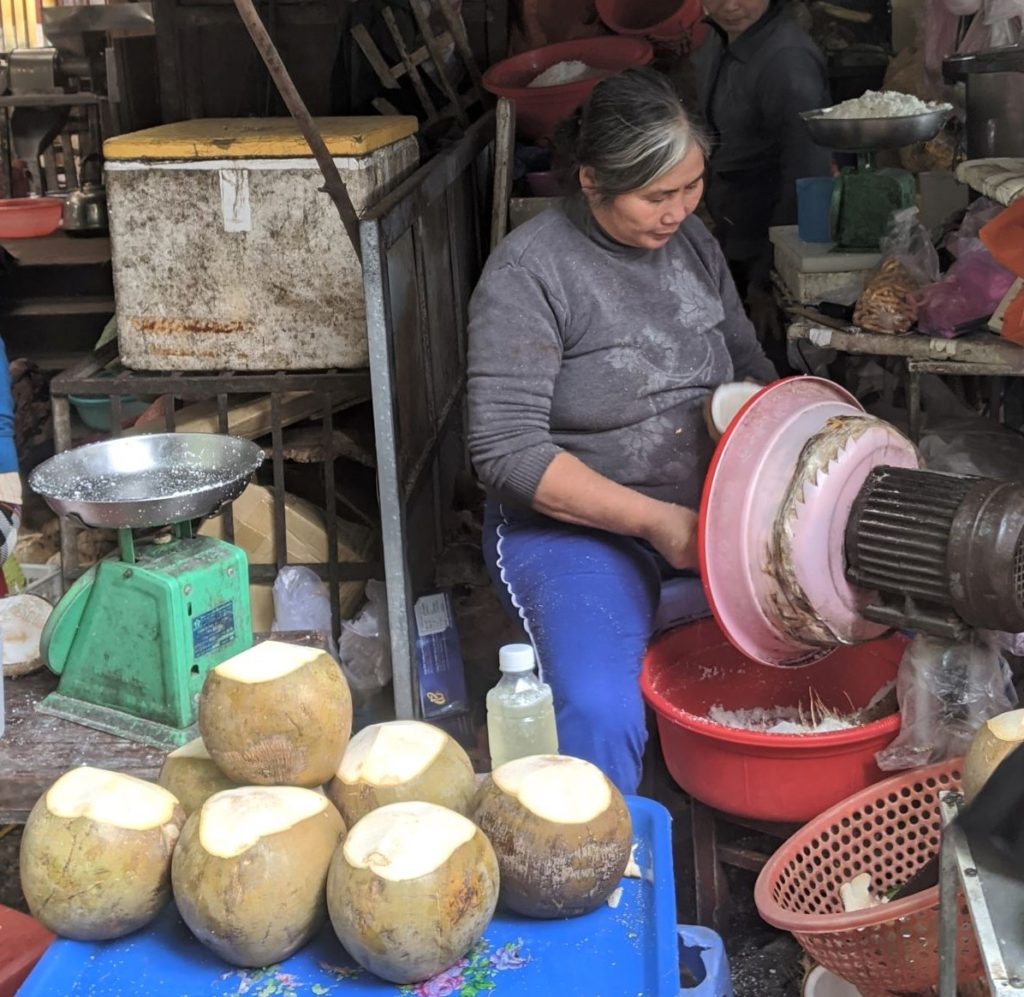My mom’s sister Shirley was an intense personality worthy of an entire blog post all by herself. Probably more than one. But I want to focus here on one small memorable thing about her: she made the best apple cake I’ve ever eaten. I’m sure many of my cousins remember, as I do, her gifts of apple cake wrapped in foil direct from her freezer, where she always seemed to have a supply.
Aunt Shirley passed away many years ago, but her apple cake lives on. And now that Dan and I have an apple tree of our own, Aunt Shirley’s apple cake has become a necessity in our lives. We make batches and batches of it in the fall. It freezes well and lasts into the following spring.
Coincidentally, I have unearthed considerable archaeological history of this cake, including facts that may be unknown to our family until now. The recipe, or its nearly identical antecedent, reappeared in my life shortly after Aunt Shirley let me copy hers. It came to me on the Usenet newsgroup rec.food.cooking in 1988 and credits “an old issue of Gourmet magazine.” The magazine article credited a Mr. John Kram, who owned a bakery in East Baltimore in the 1930s. This rings true to me: Shirley grew up in East Baltimore and might have still been living there in the ’30s. Shirley, however, called her recipe “Helen’s Apple Cake.” I don’t know who Helen is. I have also seen a version of this cake called “Jewish Apple Cake”; the Jewish Museum of Maryland may have published a version.
Without more ado, but with relevant commentary where I have made modifications, here is:
Aunt Shirley’s Apple Cake
This makes three bread pans’ worth of apple cake, and I get 8 to 9 slices per pan.
Ingredients
about 10 apples (Note 1)
2 tsp cinnamon
3 Tbsp sugar
3 C unsifted flour
1 Tbsp baking powder
1/4 tsp salt
4 unbeaten eggs
2 C sugar (Note 2)
1 C cooking oil
1/2 C orange juice (Note 2)
1 Tbsp vanilla (Note 2)
Preparation
Prepare the apples:
Core and peel the apples, and slice into wedges no more than about 1/4″ thick. Mix with the cinnamon and 3 Tbsp of sugar.
Make the batter:
In a medium bowl, mix together the flour, baking powder, and salt. (Note 3)
In the bowl of your mixer, beat the eggs, sugar, oil, orange juice, and vanilla all together. (If you haven’t already done so, now would be the time to grease and flour the baking pans.) Then add the dry ingredients to the mixer bowl, and mix just enough to blend thoroughly.
Assemble the cake:
Pour about 1/6 of the batter into the bottom of each of the 3 greased-and-floured pans, using about 1/2 of the batter in all. Layer in apple slices vertically as tightly as you can. Pour another layer of batter over the apple slices, and end with another layer of apples wedged in tightly.
Bake at 350 degrees for 1-1/2 hours (90 minutes), or until a cake tester comes out dry. (Note 4)
Wrap in foil and freeze the whole cake (as Aunt Shirley did), or cut into 8 or 9 slices, wrap each slice individually in wax paper, and freeze in a zipper freezer bag (as Dan and I do). Or eat it all up without freezing–it will keep about a week in the fridge.
Notes
(1) In the history of this cake, there has been some disagreement about the number of apples. John used 5 cups, about 1-3/4 pounds. Helen used 6 apples. Aunt Shirley said to use much more than Helen did. Dan and I are on Shirley’s side on this. Cram them in. It just gets better.
(2) Shirley and Helen used 2-1/2 cups of sugar, but I find this much too sweet. I side with John on the sugar; 2 cups is plenty. Shirley and Helen used 1/3 cup of orange juice, but John used 1/2 cup. I’ve tried them both; either works fine. As for the vanilla, John used only 2 tsp; Shirley and Helen increased this to 2-1/2 tsp. I am a vanilla extremist, so I use 3 tsp (1 Tbsp).
(3) There is a strong divide when it comes to process. The article in Gourmet magazine alleges that John went through an elaborate procedure worthy of the magazine’s title, specifying what went in first, second, third, and so on. Shirley and Helen, on the other hand, just said, “Beat all together until smooth.” I’ve tried this a number of ways, and I’m generally in the Shirley camp. However, I’ve noticed that in the presence of the orange juice, the baking powder starts activating. So I like to wait to add the dry ingredients until everything else is ready and the cake can be assembled.
(4) John used a tube pan and baked the cake for only 50 minutes to an hour. Helen baked the cake for an hour and a half, but I don’t know what kind of pan(s) she used. Shirley baked the cake for 1-3/4 hours. Maybe my oven is different from hers, but I find that 1-1/2 hours works perfectly for me, every time.



















